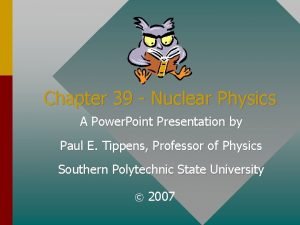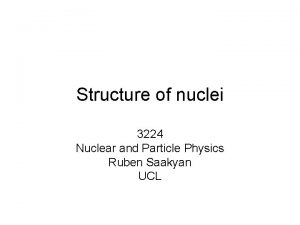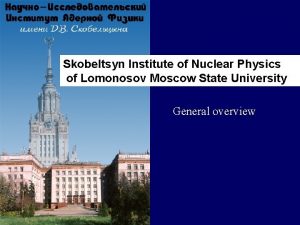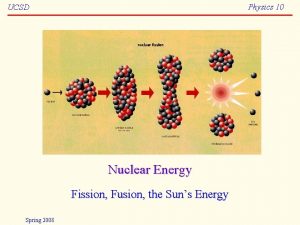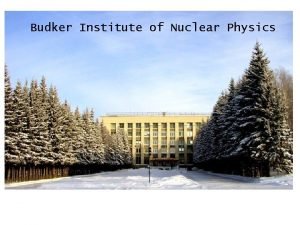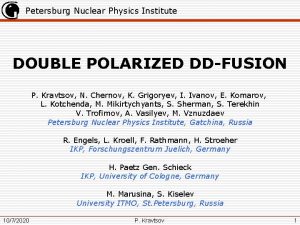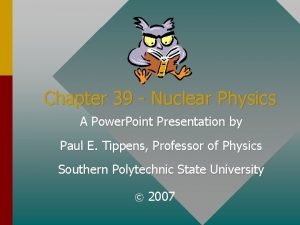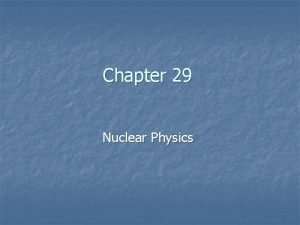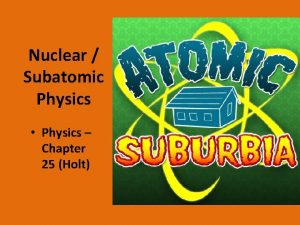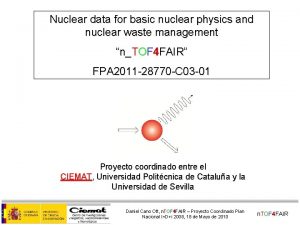Chapter 39 Nuclear Physics A Power Point Presentation













- Slides: 13

Chapter 39 - Nuclear Physics A Power. Point Presentation by Paul E. Tippens, Professor of Physics Southern Polytechnic State University © 2007

Objectives: After completing this module, you should be able to: • Define and apply the concepts of mass number, atomic number, and isotopes. • Calculate the mass defect and the binding energy per nucleon for a particular isotope. • Define and apply concepts of radioactive decay and nuclear reactions. • State the various conservation laws, and discuss their application for nuclear reactions.

Composition of Matter All of matter is composed of at least three fundamental particles (approximations): Particle Fig. Sym Mass Charge 9. 11 x 10 -31 kg -1. 6 x 10 -19 C Size Electron e- Proton p 1. 673 x 10 -27 kg +1. 6 x 10 -19 C 3 fm Neutron n 1. 675 x 10 -31 kg 0 3 fm The mass of the proton and neutron are close, but they are about 1840 times the mass of an electron.

The Atomic Nucleus Compacted nucleus: 4 protons 5 neutrons Since atom is electrically neutral, there must be 4 electrons Beryllium Atom

Thompson’s Model for the Atom J. J. Thompson’s plum pudding model consists of a sphere of positive charge with electrons embedded inside. This model would explain that most of the mass was positive charge and that the atom was electrically neutral. Positive pudding Electron Thompson’s plum pudding The size of the atom ( 10 -10 m) prevented direct confirmation.

Modern Atomic Theory The Bohr atom, which is sometimes shown with electrons as planetary particles, is no longer a valid representation of an atom, but it is used here to simplify our discussion of energy levels. The uncertain position of an electron is now described as a probability distribution—loosely referred to as an electron cloud.

Definitions A nucleon is a general term to denote a nuclear particle - that is, either a proton or a neutron. The atomic number Z of an element is equal to the number of protons in the nucleus of that element. The mass number A of an element is equal to the total number of nucleons (protons + neutrons). The mass number A of any element is equal to the sum of the atomic number Z and the number of neutrons N : A=N+Z

Symbol Notation A convenient way of describing an element is by giving its mass number and its atomic number, along with the chemical symbol for that element. For example, consider beryllium (Be):

Example 1: Describe the nucleus of a lithium atom which has a mass number of 7 and an atomic number of 3. A = 7; Z = 3; N = ? N=A–Z= 7 -3 neutrons: N = 4 Protons: Z=3 Electrons: Same as Z Lithium Atom

Isotopes of Elements Isotopes are atoms that have the same number of protons (Z 1= Z 2), but a different number of neutrons (N). (A 1 A 2) Isotopes of helium Helium - 3 Helium - 4

Nuclides Because of the existence of so many isotopes, the term element is sometimes confusing. The term nuclide is better. A nuclide is an atom that has a definite mass number A and Z-number. A list of nuclides will include isotopes. The following are best described as nuclides:

Atomic Mass Unit, u One atomic mass unit (1 u) is equal to onetwelfth of the mass of the most abundant form of the carbon atom--carbon-12. Atomic mass unit: 1 u = 1. 6606 x 10 -27 kg Common atomic masses: Proton: 1. 007276 u Neutron: 1. 008665 u Electron: 0. 00055 u Hydrogen: 1. 007825 u

Exampe 2: The average atomic mass of Boron-11 is 11. 009305 u. What is the mass of the nucleus of one boron atom in kg? = 11. 009305 Electron: 0. 00055 u The mass of the nucleus is the atomic mass less the mass of Z = 5 electrons: Mass = 11. 009305 u – 5(0. 00055 u) 1 boron nucleus = 11. 00656 u m = 1. 83 x 10 -26 kg
 Nuclear physics topics for presentation
Nuclear physics topics for presentation Lesson 15 nuclear quest nuclear reactions
Lesson 15 nuclear quest nuclear reactions Fisión nuclear vs fision nuclear
Fisión nuclear vs fision nuclear Topics for powerpoint presentation for class 4
Topics for powerpoint presentation for class 4 Power point presentation design west vancouver
Power point presentation design west vancouver Real power and reactive power
Real power and reactive power Power bi power point
Power bi power point Quantum and nuclear physics
Quantum and nuclear physics Magic number in nuclear physics
Magic number in nuclear physics Skobeltsyn institute of nuclear physics
Skobeltsyn institute of nuclear physics Nuclear energy in physics
Nuclear energy in physics Scattering cross section in nuclear physics
Scattering cross section in nuclear physics Budker institute of nuclear physics
Budker institute of nuclear physics Petersburg nuclear physics institute
Petersburg nuclear physics institute
